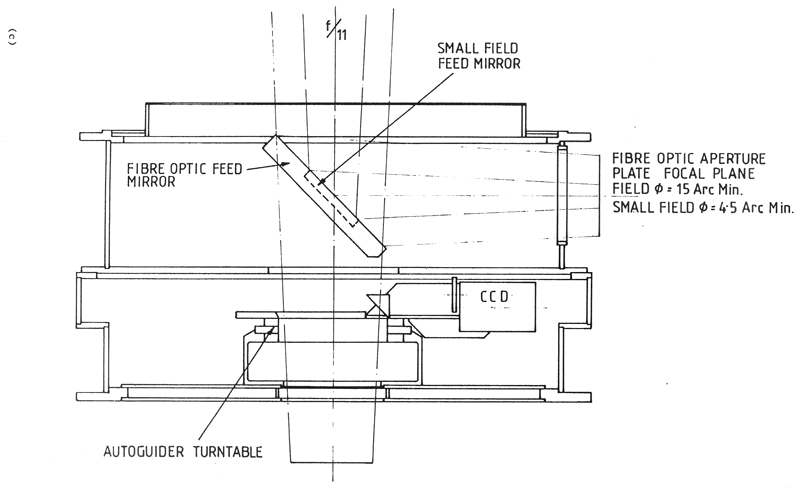 .
It is described
in some detail in La Palma Technical Note 56. Briefly, the unit has
a full field of 15 arcminute diameter at the nominal telecope focus,
15 cm below the A&G to instrument interface.
The following functions are provided
.
It is described
in some detail in La Palma Technical Note 56. Briefly, the unit has
a full field of 15 arcminute diameter at the nominal telecope focus,
15 cm below the A&G to instrument interface.
The following functions are provided




The layout of the Cassegrain A&G Unit is shown in Figure  .
It is described
in some detail in La Palma Technical Note 56. Briefly, the unit has
a full field of 15 arcminute diameter at the nominal telecope focus,
15 cm below the A&G to instrument interface.
The following functions are provided
.
It is described
in some detail in La Palma Technical Note 56. Briefly, the unit has
a full field of 15 arcminute diameter at the nominal telecope focus,
15 cm below the A&G to instrument interface.
The following functions are provided

[ TIFF ]

[ TIFF ]

[ TIFF ]
Figure: Three
views of the Cassegrain acquisition and guider unit
for the WHT. (a) Plan, showing the autoguider, cable wrap and filter slides.
(b) Elevation, showing TV, autoguider and comparison system. (c) Elevation,
showing the large and small feed mirrors and
the auxiliary port.
 . It is possible to interpose a focal reducing system,
which provides a larger field of 4 arcmin at a scale of
12 arcsec mm
. It is possible to interpose a focal reducing system,
which provides a larger field of 4 arcmin at a scale of
12 arcsec mm . The TV camera is provided
with a filter wheel with six filter positions. The filters normally
mounted are B (BG28), V (BG 38), R (RG 630), CLEAR (UBK7) and EMPTY.
The B, V, R, and CLEAR filters all have the same thickness, and the TV
can be focussed independently to compensate for different filter
thicknesses.
. The TV camera is provided
with a filter wheel with six filter positions. The filters normally
mounted are B (BG28), V (BG 38), R (RG 630), CLEAR (UBK7) and EMPTY.
The B, V, R, and CLEAR filters all have the same thickness, and the TV
can be focussed independently to compensate for different filter
thicknesses.
 equals 152 square arcmin or 0.04 square degrees.
This gives a good chance of finding a star brighter than 11th magnitude
at the galactic equator or 13th magnitude at the galactic pole
(C.W.Allen, Astrophysical Quantities, publ. Athlone Press, 1976).
The first 35 of the range of travel of the autoguider probe causes
vignetting of the slit-viewing optics and is not normally used.
equals 152 square arcmin or 0.04 square degrees.
This gives a good chance of finding a star brighter than 11th magnitude
at the galactic equator or 13th magnitude at the galactic pole
(C.W.Allen, Astrophysical Quantities, publ. Athlone Press, 1976).
The first 35 of the range of travel of the autoguider probe causes
vignetting of the slit-viewing optics and is not normally used.
The autoguider is provided with a filter wheel with six filter positions. CLEAR (UBK7), B (BG28), V (BG38), I (RG630), OPAQUE and EMPTY. The B, V, I and CLEAR filters all have the same thickness. The autoguider can be focussed independently to compensate for different filter thicknesses.
The light guides incur losses of about a factor of ten, so the lamps which are fed directly are very much brighter. Lamps can be interchanged by technical staff upon request.
Two eight-position filter wheels are provided for the comparison system. ND and colour filters similar to the set used on the INT A&G comparison system are provided to give a range of ND from 0 to 5. Two filter positions in each wheel are available for colour filters, BG24, GG375 and GG495 filters are normally mounted.
An alternative mirror (small feed flat), may be extended from the opposite side of the case, coplanar with the fibre-optic feed mirror, to direct light to a CCD camera or other small instrument at the auxiliary focus. A six-position filter wheel for 50mm filters and a shutter are provided for use with a CCD. The field available is 4.5 arcmin and the autoguider may be used.
The recommended method for finding guide stars is to select them from
the Space Telescope Guide Star Catalogue (GSC) using the GSS software
described in section  . The coordinate
conversions between position and probe coordinates are given in ``The
Guide Star Search Software: Preliminary User Guide, by R.A. Laing.
. The coordinate
conversions between position and probe coordinates are given in ``The
Guide Star Search Software: Preliminary User Guide, by R.A. Laing.



